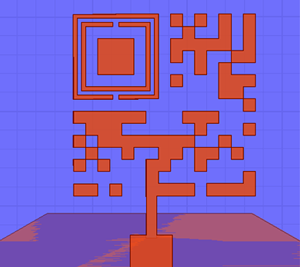Patch antennas based on micro QR codes
DOI:
https://doi.org/10.3103/S073527272307004XKeywords:
amplitude-frequency response, Ansys HFSS, metamaterial, Micro QR, patch antenna, power supply, Return Loss, VSWRAbstract
The article proposes a new type of broadband patch antennas based on micro QR codes with integrated metamaterial cell as a marker. In this research, several design options were considered that used the variation of the metamaterial cell parameters. For their analysis, the numerical modeling methods of the Ansys EM Suite program were used due to the complexity of describing the interaction of antennas of non-Euclidean geometry with radio waves. Evaluation and comparison of proposed antennas was conducted by the following characteristics: amplitude-frequency response and voltage standing wave ratio. To expand the frequency band of the synthesized antenna has been implemented the split square marker is an element of micro QR. This approach enables the expansion of the relative bandwidth of the corresponding printed antenna to the value of 1.7267 under the condition of the continuous transmission band having a width of 167.935 GHz within the range from 13.29 to 181.225 GHz. In this case, cutouts of the split square marker are located along the line coaxial with the power supply line, and the cutout for the outer “ring” is located below. To synthesize micro QR code, the word “antenna” was used.
References
- Z. E. Ankarali, B. Pekoz, H. Arslan, “Flexible radio access beyond 5G: A future projection on waveform, numerology, and frame design principles,” IEEE Access, vol. 5, pp. 18295–18309, 2017, doi: https://doi.org/10.1109/ACCESS.2017.2684783.
- T. S. Rappaport et al., “Wireless communications and applications above 100 GHz: Opportunities and challenges for 6G and beyond,” IEEE Access, vol. 7, pp. 78729–78757, 2019, doi: https://doi.org/10.1109/ACCESS.2019.2921522.
- M. H. Alsharif, M. A. M. Albreem, A. A. A. Solyman, S. Kim, “Toward 6G communication networks: Terahertz frequency challenges and open research issues,” Comput. Mater. Contin., vol. 66, no. 3, pp. 2831–2842, 2021, doi: https://doi.org/10.32604/cmc.2021.013176.
- H. Zhang, B. Di, L. Song, Z. Han, Reconfigurable Intelligent Surface-Empowered 6G. Cham: Springer International Publishing, 2021, doi: https://doi.org/10.1007/978-3-030-73499-2.
- S. Zhao, B. Xie, Z. Liu, J. An, “Reconfigurable intelligent surface-assisted radar deception electronic counter-countermeasures,” Remote Sens., vol. 15, no. 21, p. 5149, 2023, doi: https://doi.org/10.3390/rs15215149.
- V. I. Slyusar, “A family of face products of matrices and its properties,” Cybern. Syst. Anal., vol. 35, no. 3, pp. 379–384, 1999, doi: https://doi.org/10.1007/BF02733426.
- V. I. Slyusar, “Generalized face-splitting matrix products in models of digital antenna arrays with nonidentical channels,” Izv. Vyss. Uchebnykh Zaved. Radioelektronika, vol. 46, no. 10, pp. 15–26, 2003.
- V. I. Slyusar, “New operations of matrix products for application of radars,” in IEEE MTT/ED/AP West Ukraine Chapter DIPED - 97. Direct and Inverse Problems of Electromagnetic and Acoustic Theory (IEEE Cat. No.97TH8343), 1997, pp. 73–74, doi: https://doi.org/10.1109/DIPED.1997.710918.
- D. Anagnostou, W. Cross, J. Meruga, J. Kellar, “Optically scannable code antenna,” US Patent Application Publication US 2014/0263662 A1, 2014.
- A. M. Numan-Al-Mobin, J. M. Meruga, W. M. Cross, J. J. Kellar, D. E. Anagnostou, “QR code antenna for wireless and security applications,” in 2013 IEEE Antennas and Propagation Society International Symposium (APSURSI), 2013, pp. 1728–1729, doi: https://doi.org/10.1109/APS.2013.6711523.
- A. M. Numan-Al-Mobin, J. M. Meruga, W. M. Cross, J. J. Kellar, D. E. Anagnostou, “QR code antennas for WiFi/WLAN/Bluetooth applications,” in IEEE International Conference on Electro-Information Technology , EIT 2013, 2013, pp. 1–2, doi: https://doi.org/10.1109/EIT.2013.6632693.
- A. Md Numan-Al-Mobin, W. M. Cross, J. J. Kellar, D. E. Anagnostou, “RFID integrated QR code tag antenna,” in 2015 IEEE MTT-S International Microwave Symposium, 2015, pp. 1–3, doi: https://doi.org/10.1109/MWSYM.2015.7167044.
- G. S. Vardhan, N. Sivadasan, A. Dutta, “QR-code based chipless RFID system for unique identification,” in 2016 IEEE International Conference on RFID Technology and Applications (RFID-TA), 2016, pp. 35–39, doi: https://doi.org/10.1109/RFID-TA.2016.7750744.
- J. Doroshewitz, A. Kaur, J. Nanzer, P. Chahal, “Multi-factor product authentication using integrated Quick Response (QR) code pixelated antenna,” Int. Symp. Microelectron., vol. 2017, no. 1, pp. 000608–000612, 2017, doi: https://doi.org/10.4071/isom-2017-THA45_101.
- V. Slyusar, I. Sliusar, “Micro QR code as the basis of patch antenna topologies,” in 2021 IEEE International Conference on Information and Telecommunication Technologies and Radio Electronics (UkrMiCo), 2021, pp. 31–34, doi: https://doi.org/10.1109/UkrMiCo52950.2021.9716614.
- S. Bankov, A. Kurushin, Calculation of antennas and microwave structures using HFSS Ansoft, [in Russian]. Moscow: Rodnik, 2009.
- “Online barcode generator.” https://barcode.tec-it.com/ru/MicroQR?data=antenna.
- “3D Code Generator.” https://printer.tools/qrcode2stl.
- V. Slyusar, “Metamaterials on antenna solutions,” in 2009 IEEE 7th Int. Conf. on Antenna Theory and Techniques (ICATT’09), 2009, pp. 19–24, doi: https://doi.org/10.1109/ICATT.2009.4435103.
- V. Slyusar, “Metamaterials in the antenna equipment: basic principles and results,” First Mile, vol. 3, no. 4, pp. 44–60, 2010.
- I. Sliusar, V. Slyusar, Y. Utkin, O. Kopishynska, “Parametric synthesis of 3D structure of SRR element of the metamaterial,” in 2020 IEEE International Conference on Problems of Infocommunications. Science and Technology (PIC S&T), 2020, pp. 577–582, doi: https://doi.org/10.1109/PICST51311.2020.9468067.
- I. Sliusar, L. Degtyareva, V. Slyusar, S. Voloshko, A. Zinchenko, “Synthesis of quasi-fractal ring antennas,” in 2019 IEEE International Scientific-Practical Conference Problems of Infocommunications, Science and Technology (PIC S&T), 2019, pp. 741–744, doi: https://doi.org/10.1109/PICST47496.2019.9061286.
- I. Sliusar, S. Voloshko, V. Slyusar, V. Smolyar, “Synthesis of quasi-fractal hemispherical dielectric resonator antennas,” in 2018 International Scientific-Practical Conference Problems of Infocommunications. Science and Technology (PIC S&T), 2018, pp. 313–316, doi: https://doi.org/10.1109/INFOCOMMST.2018.8632087.
- B. T. T. Center, “Assessment of ultra-wideband (UWB) technology, Contract No. DAAH01-88-C-0131, ARPA Order 6049,” 1990. uri: https://apps.dtic.mil/sti/tr/pdf/ADA233624.pdf.
- “5G NR (Rel-15).” https://www.3gpp.org/lte-2.
- “5G NR (Rel-17).” https://www.3gpp.org/lte-2.
- P. Gupta, “Performance improvement of millimeter wave antennas (Review),” Radioelectron. Commun. Syst., vol. 65, no. 9, pp. 447–463, 2022, doi: https://doi.org/10.3103/S0735272722100016.
- A. Aguilar et al., “Tradespace exploration of the next generation communication satellites,” in AIAA Scitech 2019 Forum, 2019, doi: https://doi.org/10.2514/6.2019-0768.
- USA SpaceX, “Starlink Kit 01437829-004, Regulatory Notices,” 2021.
- V. Slusar, “Nanoantennas. Approaches and prospects,” Electron. Sci. Technol. Bus., no. 2, pp. 58–65, 2009, uri: https://www.electronics.ru/journal/article/178.


